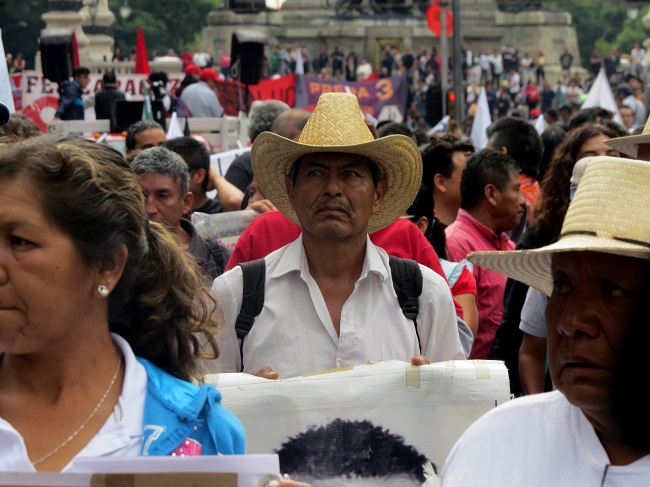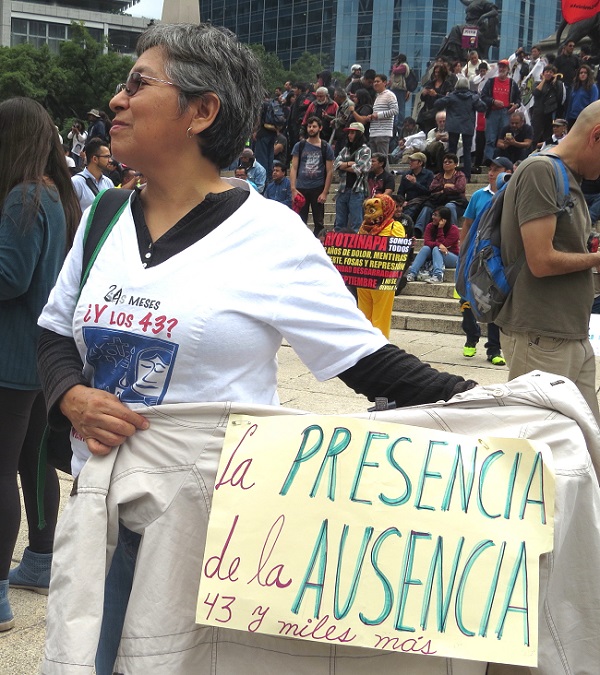
Photo: Relatives of the disappeared 43 led the march. Photos by Tamara Pearson
If 42 is the number of life, perhaps 43 is the number of life lived on through others. Today, Mexicans are chanting “Ayotzi lives, the struggle goes on” as they mark two years since the 43 teacher-students in Ayotzinapa were disappeared.
After two years of marching, touring 40 US cities, holding hundreds upon hundreds of meetings, publishing poetry, releasing documentaries about the incident, setting up exhibitions, and confronting the president with no results, people keep on going because this is the only way available to respond to criminal impunity and state inaction or complicity.
“They were taken alive, we want them (to be found) alive,” people also chanted, because they still hope the young men will be found somewhere, perhaps as prisoners. Six were killed on the night municipal police fired on students on buses headed to a Mexico City protest. The government has claimed the police then handed 43 students over to a drug cartel, which murdered them and incinerated their bodies in a garbage dump nearly 20 miles south of the town of Iguala. But forensic evidence, fire investigations, and satellite images have shown that such a fire isn’t possible. Only one of the missing student’s remains have been identified.
“Resist to exist” is one of the slogans on posters made by parents and students in Ayotzinapa for the two year anniversary. They are not just protesting impunity in this case, but for 28,472 people now reported missing in the country, according to the latest available statistics reported Wednesday by La Jornada. Further, only one in ten disappearances are formally denounced, journalist Raquel Garcia noted, meaning the amount of forced disappearances between 2006 and 2014 could be as many as 300,000 people.
Parents and family of the disappeared Ayotzinapa students counted from one to 43 as the main march in the capital kicked off. Then they screamed out “Justice!”, and other contingents of students, workers, cultural collectives, communists and anarchists, and movements against privatization also did the count.
“It was the state (who did it)” some contingents chanted and, “The terrorist state killed the teacher students,” yelled others.
“Mexico smells of death. We searched for 43, and we found dozens, hundreds, thousands (of people) without faces, without identity,” read a placard, hand-written and held by a woman in a wheelchair. She was referring to the searches communities around Ayotzinapa conducted for the 43, that uncovered many other clandestine graves, but also to the movement that has become aware of a national crisis.
“I think, then they disappear me,” read another placard, held by a student.
While Monday’s main march was peaceful, the one held on Sunday close to where the students were disappeared ended with attacks from police. An Ayotzinapa student committee reported that police launched tear gas at them as they were wrapping up, and “brutally” beat up seven students.
“We live in a country full of tombs. Every day, so many parents, brothers, sisters, and so on are looking for their family members. But despite the hunger, the rain, the heat, the demotivation, the movement is very much alive,” Carmen Brito, a retired teacher, told me.
Who’s to blame?
When it comes to unravelling Mexico’s huge disappearance figures, Journalist Federico Mastrogiovanni argues that the key is that the government, the mafia, and drug smugglers are one and the same. He also suspects that the mafia and the government “have united in order to clean up” those areas where there are valuable natural resources.
Other key factors also come into play, including the lucrative business of organized crime, an ineffective justice system that sees people taking “justice” into their own hands, the devalued lives of the poor, indigenous peoples, workers, and women, and proximity to the undeclared and ineffective world police – the United States.
In Sinaloa state for example, four doctors have been murdered so far this year, three of them in their clinics, likely by people frustrated with issues in the health system with no way to hold anyone accountable, and in a context of normalized violence.
In the small central state of Puebla, 61 women have been murdered this year, most of them by their partners. No femicides have been punished in Puebla since 2013, though 33 people are being processed for the crime.
Meanwhile, spending by the US of over $1.3 billion on training Mexican security forces has coincided with an increase in abuses, torture, and killings by those forces. Perhaps that’s why the US has been much slower to criticise the Mexican government and the human rights record here, than it has with Venezuela.
A national movement where the absent are present

Photo: Carmen Brito
Over the course of two years, the Ayotzinapa movement demanding that the 43 be returned alive, the truth, and respect for human rights, has strengthened rather than petering out. “One can’t deny that sometimes people get tired, demotivated, and with so many deaths. But our awareness that we’ve been building up, won’t die until we’re buried, not before that. After two years, I think this movement is recreating itself in favor of life. It’s never going backwards. It’s not just about the loss of the 43, but thousands of others as well,” Brito said.
After talking to various people participating in the march, it was clear that everyone was feeling the impotency to take on systematic corruption, immunity, and normalized murder. Nevertheless, there was also unanimity around the benefits of national unity among Mexico’s many and diverse movements and groups, the maturing of the movement over the last two years, and that the government, and its political, social, and economic policies, were to blame.
Mari Angulo, of the National Autonomous University of Mexico (UNAM) Union, described how some people in Mexico didn’t understand the movement’s objectives, or got distracted by other things, but insisted that, “We’ll continue, because it’s the only possibility we have. We’re not going to forget.”
“There are a lot of movements, and each one has its own dynamic – the students, the unions, the religious groups, are all different – but I can tell you that we have learned to come together, to have common objectives, act in a mature way, and to understand that all the issues are part of the one thing. We’re not having intense confrontations, instead we are coming together like a big river. Movements that are isolated don’t advance so much, they can’t change this disaster of a country. It’s about the presence of those who are absent. While we’re alive, this absence will be present,” Brito said.
Francisco Garcia Ortega, of the Popular Front Francisco Villa (FPFV), like most at the march, was clear that he was protesting a government that “steals” from the people. “The president bought a plane, when there is hunger. There is a lot of money coming in from the petroleum, electricity, resources, but we won’t see it. We’re marching to change all this, to change our reality,” he said.
Last week, the government’s lack of commitment to the Ayotzinapa case was revealed again, as President Pena Nieto appointed Tomas Zeron technical secretary of the National Security Council. The move prompted relatives of the 43 to break off dialogue with the government because Zeron had just resigned as director of Mexico’s Criminal Investigation Agency, with the relatives accusing him of “illegal actions” during the investigation into the disappearances.
“I don’t think the government wants to find out the truth. Personally, I think the truth will come out when the president’s term is over,” march participant and member of the Morena party, Elicio Leandro told me.
A key achievement of the Ayotzinapa movement after two years has been the deepened awareness by the Mexican population of the government’s corruption and ineptness. “Until now, we have managed to contain the rage, but everything has a limit,” Leandro concluded.
To paraphrase Brito, a movement that is so alive is not just fighting for the dead, it’s fighting for a better future.
Tamara Pearson is a longtime journalist on Latin America. She is the author of The Butterfly Prison.
